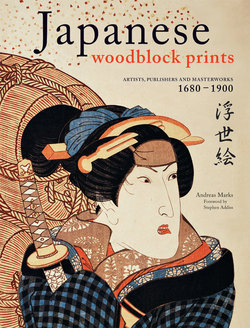Читать книгу Japanese Woodblock Prints - Andreas Marks - Страница 14
На сайте Литреса книга снята с продажи.
ОглавлениеKiyonobu
1664–1729
Given name: Shōbei. Art surname: Torii.
Born in Osaka in 1664, Kiyonobu is believed to be the son of the Osaka actor of female roles (onnagata) Torii Kiyomoto (1645–1702). Kiyomoto moved to Edo in 1687 and in 1690, started to paint kanban-e, pictures for billboards displayed in front of the theaters to announce performances, and gradually acquired a monopoly of billboard pictures and picture programs (banzuke-e) for the four main theaters. Kiyonobu succeeded as head of the family in 1702 and continued in the line of his father. He began to illustrate books and design prints and is traditionally seen as the first teacher of the Torii School establishing the style of the Torii School described as “gourd legs and earthworm outlines” (hyōtan ashi, mimizu gaki). He was especially active in depictions of the kabuki theatre as seen in signboards, playbooks, hanging scrolls, and single-sheet prints and is believed to have illustrated many of the unsigned playbooks as well. But Kiyonobu did not restrict himself to the theater and drew also beautiful women and erotica (shunga).
His earliest work seems to be illustrations in the book “One Hundred Actors of All Ages” (Kokon shibai hyakunin isshu) from 1693, and he is believed to have begun composing actor prints in 1698. He was the first to design single-sheet actor prints that capture the expressive pose (mie) and the rough acting style (aragoto) of the actors of the time. In the late 1710s, he and many others concentrated on the small and narrow hosoban format which facilitated greater productivity. Kiyonobu is thought to have designed around one hundred erotic prints, usually sold in sets of ten or twelve and mounted in albums or as hand scrolls. At least eight such sets are known to have survived.
Until 1760, prints with the signature “Kiyonobu” exist. Since 1725, the style of the signature is very different and it is therefore believed that Kiyonobu retired at that time and a second Kiyonobu continued to use the name. Kiyonobu died in the summer of 1729 and is buried at Somei Cemetary (Somei Reien). His posthumous Buddhist name is Jōgen’in Kiyonobu Hitachi Shinji.
1719 The actors Ichikawa Danjūrō II as Hiranoya Tokubei and Sanogawa Mangiku as Ohatsu of the Tenmaya in the play Sogazaki Shinjū, Nakamura Theater, IV/1719. 21.6 x 29.8 cm, sumizuri-e. Honolulu Academy of Arts: Gift of Dr. & Mrs. C.M. Cooke, 1935 (10382). Mutō 2005, no. 49.
1710s Kiyonobu (attr.) Chō Ryō (Chin. Zhang Liang), riding a dragon, returns the shoe. (Left sheet of a diptych). Hosoban tan-e. National Museum of Ethnology, Leiden, The Netherlands.
1720 The actor Fujimura Handayū I as Nishikigi in the play Michinoku Taiheiki, Nakamura Theater, XI/1720. Hosoban tan-e. Publisher: Igaya Kan’emon. Honolulu Academy of Arts: Gift of James A. Michener, 1954; photography by Tim Siegert (13429). Mutō 2005, no. 26.
1718 Kiyonobu. The actor Ichikawa Kuzō I as Miura Arajirō in the play Zen kunen yoroi kurabe, Morita Theater, XI/1718 Hosoban tan-e Publisher: Emiya Kichiemon Honolulu Academy of Arts: Gift of James A. Michener, 1988; photography by Tim Siegert (20503) Ref.: Mutō 2005, no. 9
